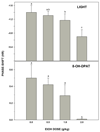Acute ethanol disrupts photic and serotonergic circadian clock phase-resetting in the mouse
- PMID: 21463340
- PMCID: PMC3132210
- DOI: 10.1111/j.1530-0277.2011.01483.x
Acute ethanol disrupts photic and serotonergic circadian clock phase-resetting in the mouse
Abstract
Background: Alcohol dependence is associated with impaired circadian rhythms and sleep. Ethanol administration disrupts circadian clock phase-resetting, suggesting a mode for the disruptive effect of alcohol dependence on the circadian timing system. In this study, we extend previous work in C57BL/6J mice to: (i) characterize the suprachiasmatic nucleus (SCN) pharmacokinetics of acute systemic ethanol administration, (ii) explore the effects of acute ethanol on photic and nonphotic phase-resetting, and (iii) determine if the SCN is a direct target for photic effects.
Methods: First, microdialysis was used to characterize the pharmacokinetics of acute intraperitoneal (i.p.) injections of 3 doses of ethanol (0.5, 1.0, and 2.0 g/kg) in the mouse SCN circadian clock. Second, the effects of acute i.p. ethanol administration on photic phase delays and serotonergic ([+]8-OH-DPAT-induced) phase advances of the circadian activity rhythm were assessed. Third, the effects of reverse-microdialysis ethanol perfusion of the SCN on photic phase-resetting were characterized.
Results: Peak ethanol levels from the 3 doses of ethanol in the SCN occurred within 20 to 40 minutes postinjection with half-lives for clearance ranging from 0.6 to 1.8 hours. Systemic ethanol treatment dose-dependently attenuated photic and serotonergic phase-resetting. This treatment also did not affect basal SCN neuronal activity as assessed by Fos expression. Intra-SCN perfusion with ethanol markedly reduced photic phase delays.
Conclusions: These results confirm that acute ethanol attenuates photic phase-delay shifts and serotonergic phase-advance shifts in the mouse. This dual effect could disrupt photic and nonphotic entrainment mechanisms governing circadian clock timing. It is also significant that the SCN clock is a direct target for disruptive effects of ethanol on photic shifting. Such actions by ethanol could underlie the disruptive effects of alcohol abuse on behavioral, physiological, and endocrine rhythms associated with alcoholism.
Copyright © 2011 by the Research Society on Alcoholism.
Figures






Similar articles
-
Acute ethanol impairs photic and nonphotic circadian phase resetting in the Syrian hamster.Am J Physiol Regul Integr Comp Physiol. 2009 Feb;296(2):R411-8. doi: 10.1152/ajpregu.90782.2008. Epub 2008 Dec 10. Am J Physiol Regul Integr Comp Physiol. 2009. PMID: 19073899 Free PMC article.
-
Chronic ethanol disrupts circadian photic entrainment and daily locomotor activity in the mouse.Alcohol Clin Exp Res. 2010 Jul;34(7):1266-73. doi: 10.1111/j.1530-0277.2010.01204.x. Epub 2010 May 7. Alcohol Clin Exp Res. 2010. PMID: 20477766 Free PMC article.
-
In vivo resetting of the hamster circadian clock by 5-HT7 receptors in the suprachiasmatic nucleus.J Neurosci. 2001 Jul 15;21(14):5351-7. doi: 10.1523/JNEUROSCI.21-14-05351.2001. J Neurosci. 2001. PMID: 11438611 Free PMC article.
-
Serotonergic innervation of the hypothalamic suprachiasmatic nucleus and photic regulation of circadian rhythms.Biol Cell. 1997 Nov;89(8):513-23. doi: 10.1016/s0248-4900(98)80007-5. Biol Cell. 1997. PMID: 9618901 Review.
-
Small molecule modifiers of circadian clocks.Cell Mol Life Sci. 2013 Aug;70(16):2985-98. doi: 10.1007/s00018-012-1207-y. Epub 2012 Nov 16. Cell Mol Life Sci. 2013. PMID: 23161063 Free PMC article. Review.
Cited by
-
The dynamics of GABA signaling: Revelations from the circadian pacemaker in the suprachiasmatic nucleus.Front Neuroendocrinol. 2017 Jan;44:35-82. doi: 10.1016/j.yfrne.2016.11.003. Epub 2016 Nov 25. Front Neuroendocrinol. 2017. PMID: 27894927 Free PMC article. Review.
-
Sex Differences in Photic Entrainment and Sensitivity to Ethanol-Induced Chronodisruption in Adult Mice After Adolescent Intermittent Ethanol Exposure.Alcohol Clin Exp Res. 2018 Nov;42(11):2144-2159. doi: 10.1111/acer.13867. Epub 2018 Sep 2. Alcohol Clin Exp Res. 2018. PMID: 30102762 Free PMC article.
-
Chronobiology of alcohol: studies in C57BL/6J and DBA/2J inbred mice.Physiol Behav. 2013 Feb 17;110-111:140-7. doi: 10.1016/j.physbeh.2013.01.001. Epub 2013 Jan 10. Physiol Behav. 2013. PMID: 23313401 Free PMC article.
-
The Molecular Circadian Clock and Alcohol-Induced Liver Injury.Biomolecules. 2015 Oct 14;5(4):2504-37. doi: 10.3390/biom5042504. Biomolecules. 2015. PMID: 26473939 Free PMC article. Review.
-
Human circadian rhythm studies: Practical guidelines for inclusion/exclusion criteria and protocol.Neurobiol Sleep Circadian Rhythms. 2022 Aug 8;13:100080. doi: 10.1016/j.nbscr.2022.100080. eCollection 2022 Nov. Neurobiol Sleep Circadian Rhythms. 2022. PMID: 35989718 Free PMC article. Review.
References
-
- Bachtell RK, Wang Y-M, Freeman P, Risinger FO, Ryabinin AE. Alcohol drinking produces brain region-selective changes in expression of inducible transcription factors. Brain Res. 2000;847:157–165. - PubMed
-
- Challet E, Pévet P. Interactions between photic and nonphotic stimuli to synchronize the master circadian clock in mammals. Front Biosci. 2003;8:246–257. - PubMed
-
- Challet EK, Scarbrough K, Penev P, Turek FW. Roles of suprachiasmatic nuclei and intergeniculate leaflets in mediating the phase-shifting effects of a serotonergic agonist and their photic modulation during subjective day. J Biol Rhythms. 1998;13:410–421. - PubMed
Publication types
MeSH terms
Substances
Grants and funding
LinkOut - more resources
Full Text Sources

